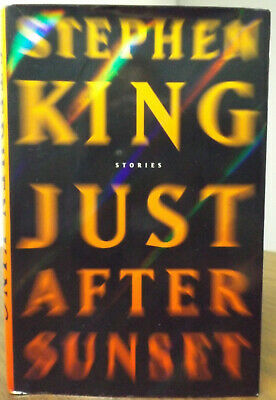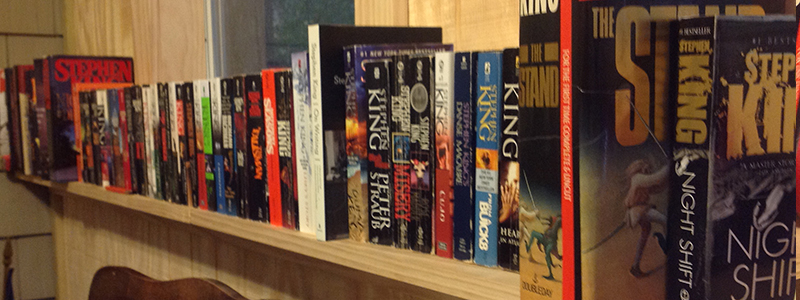The plan is to reread all of Stephen King’s works in the order that they were published. Richard Chizmar of Cemetery Dance had the vision. I’m doing it because I am a writer and I want to improve my fiction. And I love Stephen King’s stories. I think there is something to be learned through this process.
You can also go back to the beginning and read Before Carrie or any of my other posts up through this one and beyond by checking out this link to the Master List of all my #StephenKingRevisited posts.

Just After Sunset is dedicated “For Heidi Pitlor” who was connected to Best American Short Stories.
In the introduction of this short story collection, Stephen King expresses that short story writing is a diminishing skill. Unlike riding a bike, he sees writing broadly and short story writing in particular in the category of flying a plane, playing an instrument, or how some preachers view studying scripture. The longer you go without using it, the more your proficiency with it degrades to the point of “forgetting how.” King believes this happened to him as he focused on novel writing for a couple decades leading up to this 2008 collection.
It was being a guest editor for Best American Short Stories one year that he credits with reawakening his love for the form. This collection represents the stories that followed that returned practice to short story writing.
After rereading this collection, I enjoyed every story. I think after revisiting it I might actually rank it lower than other collections he’s done. Even with me “lowering it” in rankings following this revisit, I think the stories are good and entertaining.
Willa
This is the first story he wrote after his dry spell ended. He says he sees it as less than perfect, but he loves it because it represents the return of short story writing for him.
There is a belief expressed here that “moving on” is confusing and not everyone can accept that life as they knew it is over. The story shows the difficulty of convincing someone of what they don’t want to see no matter the condition of their spirit.
It’s a lovely little story about being haunted by perceptions and expectations.
The Gingerbread Girl
This story may be the one that stands out most clearly in my mind. Others come back to me once I start reading them again, but I pretty much remember this one very clearly from beginning to end right from the beginning.
We find ourselves on Vermillion Key instead of Duma Key. Stephen King spent a ton of time in Florida, so more than a few of his stories migrated there from Maine.
A heron shows up in this story. In Duma Key, the bird was a bad omen to say the least.
Running is the theme and she is running away from grief before she is running from anything else.
It’s a great surprising survival tale. I knew what was coming this time, but when I didn’t the first time, the reveal after the build-up was jarring.
Someone is wearing a “Save the Cheerleader” t-shirt. A reference from the television show Heroes that places this story firmly in its year.
Harvey’s Dream
In the author notes at the end of the collection, King says this story and one other came to him in a dream. It was more dream dictation than it was writing, he says. It reads like a dream and the title character is retelling his dream in the story.
We have late middle age resentment in this marriage.
“You always know your own” is a favorite phrase of King. It’s always around phone calls and bad news. Feels a little like a rehash of a story he’s already told in a screenplay that appeared in Nightmares & Dreamscapes.
The appeal of this story is that an ordinary dream with ordinary details is made terrifying in its otherwise seemingly ordinary retelling. Skillfully done.
The Sopranos TV show is referenced. One of the characters works at a video store. Rember when?
Rest Stop
This is a great compact tale with good cathartic violence. It’s a great piece of mild, realistic revenge fantasy. One of my favorite stories in the collection and one that has stuck with me since the first reading.
The writer character in the story thinks that Russians are out as villains. It’s funny how things come back into style.
Stationary Bike
This story was set the summer after the 911 attacks. That is a more direct time reference in another story later in the collection. I’m curious if these stories were written during those times or were referenced back to them at a later date.
King goes on a long rant through a doctor character on his distaste for fat people. It is an ongoing theme in his work over the decades. In the past, he’s demonstrated not to have a clear grasp of what actual weights are overweight. It might be a phobia of his that’s boiled under the surface all this time.
He leans into the mind of the artist as he did with Duma Key. I’m curious whether this story was written before, after, or during the writing of that novel.
Grief has been the primary motivation for exercise for Stephen King’s characters for a while. Stephen King characters always say “pitchers” instead of “pictures.”
The narrator references “the ending everyone expects” as the story tries to subvert that expectation a little.
The story wrestles with the balance between obsession and moderation.
The Things They Left Behind
This is King’s 911 story (the September 11th terror attacks) and it is a good one. It is restrained and ends in a solid place.
The Dixie Chicks are referenced and I wonder if this was written in the time period when it is set or if this cultural reference was put in when the story was written later to affirm the time period.
Graduation Afternoon
This is another one that came from a dream image. I thought it was missing something when I first read it years ago, but I like this story much better on the second read now.
Jay-Z, Beyonce, and The Frey are referenced.
N
This may arguably be the strongest story in the collection, a centerpiece. I like it a great deal, but I could also list off more than half the stories in this that I like a great deal. I’m not sure I could pinpoint this one as my favorite which I think speaks to the overall strength of the collection.
The description of finding and escaping the field is tense and scary. The passing of the curse adds to the well-formed horror. I believe he fully achieved what he was trying to invoke in this tale.
The Cat From Hell
This is the oldest story in the collection, dating back to the 1970s, some thirty years before publication at the time. I know a couple people who have strong opinions on this story. It first appeared in the Men’s Magazines back in the day.
They just keep taking this cat for a drive no matter the warning signs against it.
The New York Times at Bargain Basement Prices
This story is touching and unnerving. I thought I remembered a different ending.
There is a reference to old relatives doing email blasts. I think social media has become the outlet for that, thank goodness.
Mute
Driving to Derry and picking up a hitchhiker. What could go wrong?
Stephen King sets up an interesting dilemma around the question of “is this a sin?” and “what type of sin?”
Ayana
In more than one story, King has described the smell of old people as a yellow smell. We have a magic black child in this one. King literally references the girl by that descriptor. The medical definition of a miracle is misdiagnosis. That’s a good line.
A Very Tight Place
I remember this one well. It is gross out horror at its least apologetic. The ending, though fitting, may not be as satisfying as many readers would like.

My next post in this series will be Before Under the Done which will be linked on the Master List of all my Stephen King Revisited posts.





